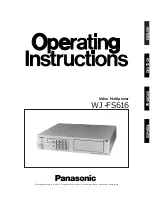
ADM-880C 07/20/09
35
The face of the exhaust hood should be divided into a grid with each section of the grid representing an equal area division
of the exhaust hood. The equal area divisions are often set at 6" x 6", and seldom need to be set at less than 4" x 4". Each
velocity sampling location should be at the center of an equal area division of the grid. All equal area divisions should be
tested. The leading edge of the AirFoil probe should be directly in line with the plane of the sash while taking face velocity
sample measurements.
The actual airstream direction is usually at various angles to the plane of the opening around the sash perimeter, so
velocities cannot be reliably measured near the edge of the opening. The tip of the AirFoil probe must be positioned at least
2 inches from the edge of the sash opening of the exhaust hoods.
The standard AirFoil probe is a straight probe. It is often difficult to position the standard probe across an exhaust hood
opening if the hood opening frame has some relief depth on the sides and at the threshold. Special pattern AirFoil probes
are available that have the end of the probe at 90 degrees to the shaft. These probes are more easily positioned in such
hood openings and are designed to fit in the AirData Multimeter accessory kit carrying case.
6.3.4 LAMINAR FLOW WORKSTATIONS - AIRFOIL PROBE
The AirFoil probe may also be used to measure face velocities and work zone velocities for very small sample areas. The
average of several readings must be used to represent small sample areas, due to the variability of air flow at low velocities.
Readings that vary ± 50% are not unusual when taking single point velocity readings. The more variable the readings, the
more readings must be included in the average obtained at each location. Ten readings per sample point is usually
adequate.
6.4 SINGLE POINT CENTERLINE AIR VELOCITY MEASUREMENTS
It may be necessary to take single point centerline air velocity readings using the AirFoil probe or pitot tube under certain
test conditions. These conditions may include very small ductwork (minimum size is four inches) or other situations where
it is very difficult to perform a full pitot tube traverse and it is not appropriate to use the FlowHood.
Position the pitot tube or AirFoil probe carefully in the center of the duct. Take five or more velocity readings and determine
the average of the readings. Multiply the average of the readings by a factor of 0.9 to calculate the approximate average
velocity for the duct.
6.5 VELGRID AIR VELOCITY
IMPORTANT: See Section 6.1 VELOCITY CORRECTION FACTORS
The VelGrid accessory is designed especially for use in the measurement of general "face velocity" conditions, such as
HEPA clean room filter outlets; laminar flow work benches; exhaust hoods; terminal air face velocities; and large filter bank
and coil face velocity measurements. The measurement range using the VelGrid is 25 to 2500 fpm. Each reading
represents 16 velocity points over a 14" x 14" area (1.36 sq ft).
The VelGrid unit is assembled by attaching the pushbutton handle to one of the captive knob screws of the handle bracket,
and attaching one or more of the extension rods to the other end of the handle bracket as shown in Figure 6.3. The VelGrid
swivel bracket is attached to the extension rod end. The two hoses are connected to the VelGrid hose connectors and to
the ports on the meter. The pushbutton handle cord plugs into the external read jack on the left side of the meter. A
neckstrap is provided with the VelGrid to support the meter and allow hands free operation. The TemProbe must also be
used as discussed if full density correction for temperature is required. If the TemProbe is not used, the velocity will be
calculated using the standard temperature of 70
/
F or 21.1
/
C.
After turning the meter on, press the MODE key until [VELGRID] is displayed, followed by [FP READ]. Press the READ
key to initiate the actual measurement. (Press the STORE key if the memory function is desired). [STORE RDY] will be
displayed. Place the VelGrid directly on the face of the filter or coil, with the standoff spacers of the grid against the outlet
or inlet face. When placing the VelGrid near the edges of the filter, grille, coil face, or other opening, the perimeter standoff
spacers should be at least 1.5" from the edge of the
active
face area. This 1.5" margin maintains the proper "traverse"
spacing of the velocity sample points at 3.5" centers on a 14" x 14" area.
Overlapping of reading positions is better than getting too close to the face area edges. If the dimensions of the outlet are
smaller than the VelGrid, the orifices of the grid that are not directly exposed to the air flow must be covered with tape. All
unused orifice positions on
both
sides of the grid manifold
must
be covered. Note: The VelGrid temperature exposure limit
is 0
/
F to 140
/
F.
The VelGrid is bidirectional in function. A negative sign will be displayed if the hose connections are reversed or if the air
flow direction is reversed in relation to the higher pressure side of the VelGrid. If you know that the hoses are reversed, you
may disregard the negative sign.
Содержание AIRDATA ADM-880C
Страница 42: ...ADM 880C 07 20 09 37 FIGURE 6 3 VELGRID ASSEMBLY...
Страница 50: ...ADM 880C 07 20 09 45 FIGURE 10 1 FRAME STORAGE FIGURE 10 2 FLOWHOOD IN CASE...
Страница 51: ...ADM 880C 07 20 09 46 FIGURE 10 3 FLOWHOOD ASSEMBLY...
Страница 53: ...ADM 880C 07 20 09 48 FIGURE 10 7 1X5 FRAME ASSEMBLY FIGURE 10 8 3X3 FRAME ASSEMBLY...
















































